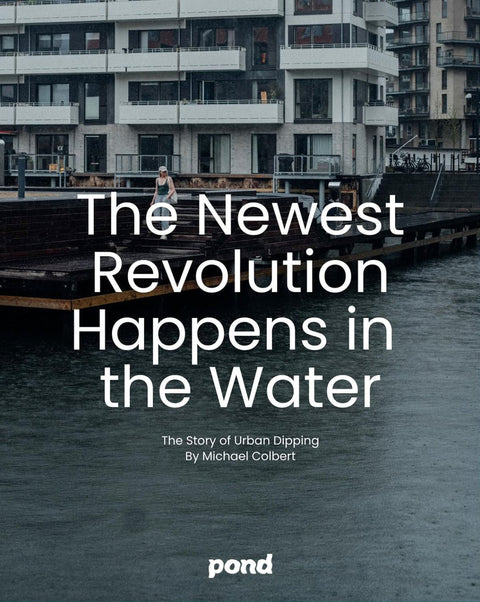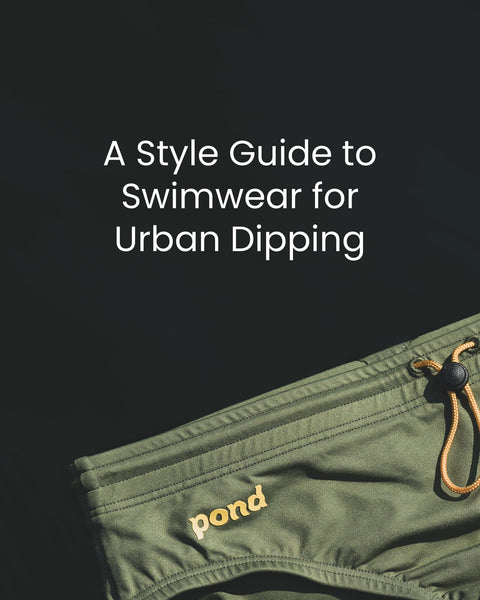
It’s a windy night in Copenhagen. A cool mist hangs lightly over the harbor. Before thinking twice about it, a group of off-the-clock city dwellers proceeds out of the sauna and plunges into the harbor. The water is cool, but it’s never felt better. From their vantage in the drink, the city’s buildings rise up all around them. Everyone here has gathered to practice the art of urban dipping.
On nights like these, Pond’s urban dip club assembles. In hidden spots along Copenhagen’s Inner Harbour, people convene for a night of saunas, food, and a plunge into the water. This year, Pond has hosted four Dip Clubs, in January, March, June, and September. One month, a repurposed fishing boat pulled up, and Dip Club members slipped inside the seaworthy sauna for a good sweat before jumping not into a cold plunge but Copenhagen’s Inner Harbour. A sauna master guided the practitioners through the experience before everyone wound down with hot coffee, beer, and a light bite. Evenings like these are a leisurely affair, providing people with an opportunity to connect with each other and their city from a place they might not have imagined possible before: urban waterways.

Around 75 people gather for each Dip Club session in Copenhagen's clean harbour
What is Urban Dipping?
Urban dipping has been becoming more of a phenomenon around the world, but what exactly is it?
While the term might evoke Katharine Hepburn swimming in Venice’s less than immaculate canals, what it looks like and entails today is similar but different.
Like Hepburn’s fabled Venetian swim, the art of the urban dip has playfulness at its core. It's a stroll instead of a powerwalk, a jog instead of a run, a dip instead of, well, a swim. Fundamentally, urban dipping is about embracing leisure. It’s a recreational activity, oriented towards enjoying a slowed-down lifestyle within the city’s unique urban landscape.
While lots of cities in southern Europe are built on the sea and have swimming and lounging on beaches stitched into their culture, Copenhagen is well positioned as a hotbed for cold dips. Urban dipping encapsulates life around the harbor, foregrounding an appreciation for the water without sand and palm trees. With such a massive harbor as a central feature of the city’s design, people have been wondering how it can be used for many activities and support the lives and pleasure of the city’s 1.4 million residents.
Truth be told, the question for Copenhagen, is somewhat new. Copenhagen has undergone a significant transformation since the 90s. As industrial buildings moved out of the city, the city committed significant resources and time to cleaning up the harbor. “According to Jørgen Lund Madsen, Copenhagen’s head of Water and Environmental Impact Assessments, it took 3 billion Danish kroner (about $440 million) to reroute wastewater, build overflow barriers, and create underground water-storage vessels to ready the harbor for swimming,” Bloomberg reports. The investment altered city life in a valuable way; Copenhageners could swim in their beloved harbor again. Additionally, with fewer parks on land, the city suddenly found itself in possession of a massive blue park, a place where people can connect with the outdoors within the city limits year-round.

The orange rescue ladders - strewn all around Copehagen's harbour - are being used for urban dipping. Talks are on to legalise swimming all over the harbour.
The development has been a welcome change to the city for many. COVID sparked a deep desire - and deep appreciation - for easy access nature. Through the pandemic, people from Los Angeles to London wanted to find ways to spend time outdoors without getting in a car or on a train and hauling it out of the city. With the harbor cleaned up, people in Copenhagen took to the water.
The city has a long history of swimming clubs. For over 100 years, swimming clubs along the piers of the city’s Outer Harbour have provided people with a place to kick back in the sauna, dip in the water, and meet up with a friend after for dinner downtown. With precious summers and long winters, people itch for a place to unwind within the city limits. While these facilities are simple - offering changing rooms, a sauna, and access to the Outer Harbour - the clubs remain fairly exclusive, and their waiting lists stretch on, seemingly endless. Through the pandemic, more mobile saunas sprang up throughout the city as people itched to partake in a fundamental Scandinavian tradition: a sauna and a cold plunge.
With Dip Club, though, Pond wants to democratize access to the harbor. Building on the city’s affinity for fresh air and cold water, the dip club looks to participate in forming the city’s Nordic answer to Mediterranean bathing culture in Nice or Barcelona. In Copenhagen, people brave the wind and rain for a soak, nice conversation, and city views from within the historic harbor. The Pond Dip Club is a grassroots community. Good vibes, good times.
“Obviously you don’t need us to dip in the harbor,” said Pond co-founder and CEO Mikkel Bechshøft. All that the urban dip requires is a towel, a good spot along the harbor, and a pair of swim briefs. No key card access or club memberships, just an appreciation for the art of unwinding and a willingness to brave some chilly weather.
“How can you use the harbor for many kinds of activities?” asked Bechshøft. “We’re just trying to add to the culture and maybe also build our tiny fraction of the whole culture. Where do you eat, where do you drink, where do you party, where do you dip?”
A Global Phenomenon Making Waves
While Copenhagen has been enjoying its own flavor of urban dipping, it’s by no means an exclusively Danish phenomenon. Scandinavia is well-known the world around for sauna culture. People in cities from Turkey to Japan have enjoyed their own sauna, onsen, and bathhouse culture within their city limits for centuries. Sydney’s Bondi Icebergs Club has had members swimming in their iconic pools on the edge of the South Pacific since 1929.

Badeshiff in Berlin. Photo by Thorsten Seidel.
However, the art of the outdoor dip within a city’s waterways is a newer phenomenon, and the story cannot be told without also examining municipal efforts to address pollution.
Landlocked Switzerland has long been a proponent of their own spin on urban dipping, cleaning up their rivers and lakes and constructing pools for outdoor swimming in Geneva, Zurich, and Brussels:
“In the last few decades, Swiss cities have become pioneers of the urban swimming movement, making their rivers available as natural public spaces within the built environment. In Switzerland today it is common to see workers taking a dip in their lunch break, or even swimming their way to work in the morning, whilst the rest of the world looks on in awe.”-Tasha Day, Pop Up City
The inspiration has filtered throughout Europe. The United Kingdom has seen a revival of the lido, and in London, Thames Baths is proposing a project similar to the work undertaken in Copenhagen––to get people swimming in the Thames once more: “The proposals look to re-establish an intimate and playful link between Londoners and this historic lifeblood of the city. Our vision is to inspire people in cities around the world to reclaim their rivers for swimming and increased public use.”

Thames Baths rendering from Studio Octopi
Chris Romer-Lee, co-founder of Studio Octopi, which designed Thames Baths, points to some of the perceived health benefits as one of the catalysts of the phenomenon across time.
“There was a strongly held belief that the immersion in––and consumption of––sea water would cure most ailments,” said Romer-Lee.
Romer-Lee became enthralled with the art of the urban dip through Studio Octopi’s work on Thames Baths. He swims daily in London’s Hyde Park and has become an afficionado of the practice. “I’ve travelled across Europe and our friends in Copenhagen, Basel, Zurich, and now Paris are all doing some great work, showing the power and pull of clean accessible urban water,” he said.
The work has become a springboard to promote similar clean-ups and innovation around the world, too.
“Through Thames Baths we’ve collaborated with many community groups on refurbishing existing 1930s outdoor pools or designing new ones,” he said. “This has then moved to international work on floating pools for Melbourne, as way of getting Melbournians into the Yarra River and in Sydney, where we worked with Sydney Water on a technical report examining how new swim sites could be established around Greater Sydney, particularly in western districts of the harbour.”
And with the 2024 Olympics coming in Paris, a 1.4 billion euro effort to clean the Seine is projected to make the river fit for swimming again for the first time in a century. Time reports that enthusiasm for the city’s efforts, a landmark for a city of this size, could inspire similar efforts in other major metropolises around the world.

The Seine legacy as envisaged by the Olympics 2024 Committee
Urban dipping is making its way across the pond as well. In New York, the team at + POOL has made it their mission to help people “connect with nature and explore the city from a unique perspective” through river swimming.
"The waters surrounding New York City were once open and accessible to all, but in the early 1900s, rapid war-time industrial development and population growth began to have an impact on the quality of urban waters, and as a result, public access to waters for swimming were restricted. + POOL started as a simple idea…instead of trying to clean the entire river, what if you could clean a small piece of it. And what if you could change how New Yorkers see their rivers, just by giving them a chance to swim in it?" + POOL
The folks at + POOL are working to design a pool that will function as a filter, cleaning the river as it passes through so people can enjoy their city from inside the water. Like projects elsewhere, + POOL is organized around creating “a healthier, more vibrant, and inclusive urban environment for all residents and visitors to enjoy.” + POOL sets out to be a public good for both lap swimmers and swim classes to enjoy a dip in the pool’s different wings. Through these many efforts around the world, one thing is clear: there’s something magnetic to unplugging from urban life and jumping into the water.
Other cities around the U.S. are proposing similar projects. Boston Harbor has featured center stage throughout the city’s history, from the Boston Tea Party to the Head of the Charles regatta. While people today enjoy boating, kayaking, and stand-up paddle boarding across the Charles, the city’s Swim Park Project seeks to “build a safe, fun, and accessible seasonal swimming facility in the Charles River to be enjoyed by all. The CRC wants to celebrate the environmental success and improvements to the Charles River’s water quality.” The Charles River Conservancy also aims “to connect people to the river and inspire continuing advocacy for the Charles’ health.” Throughout the world, urban dipping and environmental advocacy go hand in hand.
There’s something democratic to the story of urban dipping, too. On a warming planet with recent summers clocking in as the hottest on record, people need affordable ways to stay cool. If they can do so just catching the metro or walking a few blocks to the waterfront from their apartment, the solution feels that much more workable. The minds behind many of these efforts believe that by building a bond between people and their urban ecosystems through cleaner rivers and harbors, there’s a stronger opportunity for climate advocacy on the local level. If an evening in the river is part of people’s weekly routine, they might be more inclined to support cleaner water and air.
Ready to Dip? Suit Up
The rise of urban dipping coincides with another ascendant global fashion phenomenon: the speedo. And for urban dippers, the swim brief marries form and function.
In terms of style, the speedo is well-suited to all body types. Instead of board shorts, which pinch in the wrong places and hide the right ones, the speedo is a simple, versatile, and stylish garment, and men around the world have been catching on. The speedo is back.
Speedo Inc. - the original purveyors of the much-maligned piece of skimpy swimwear - argue yes, reporting that "...in 2023, sales and orders across Europe, the Middle East and Africa are up by over 200% compared with 2022. Meanwhile in the US, the brand reports a 54% sales increase from 2020 to 2021 and are expecting to exceed this for 2023." –Martha Alexander, CNN
While the speedo has long been preferred throughout Australia, France, and Brazil, in certain parts of Europe and North America, swim briefs have been much maligned. Oftentimes, the designs have been fairly limited too, cut either to hem in the bodies of Olympic swimmers or limit exposure for oiled-up men on the beach. The fabrics and designs seem conceived of purely for sport or purely for show.
The founders of Pond wanted to offer something else, a practical, comfortable suit for the everyday urban man to wear on an easy swim in the city. The suits are simple; someone can throw one in their bag and put it on after work. Slipping one on, you don’t feel like a Michael Phelps wannabe or South Beach impostor, instead: relaxed, ergonomic, Scandinavian. The swimsuits are designed with the ethos of urban dipping in mind.
And, perhaps most importantly, they’re the perfect companion for the sensation of the urban dip. While the ideal sauna takes place nude, Bechshøft notes, the swim brief is a potent alternative.

What's the next best thing to be naked in the sauna? Well, it's a swim brief.
“A lot of city dwellers aren’t really comfortable being naked in the sauna, even though that's maybe tradition in some places,” said Bechshøft, “so what's the next best thing to be naked? Well, it's a swim brief. You don't get burnt thighs from the fabric heating up way too much. You can go directly from the sauna into the water. We think that style is perfectly suited for urban dipping.”
On a gray morning in my city in Maine, I wanted to put it to the test. The summer has been rainy, the wettest I remember. Living here, I’m surrounded by water, but so often it’s a backdrop. Before work, when the dogwalkers were escorting their pets off the beach, I ran down to the ocean to the beach a few blocks from my old apartment downtown.
Unencumbered, I jumped into the ocean. There was something meditative to this pause before the workday, a moment to catch my breath before heading downtown to resume my day. I moved freely through the water and soaked up the city from within.
This piece is written by Michael Colbert, freelance journalist, Maine, US


